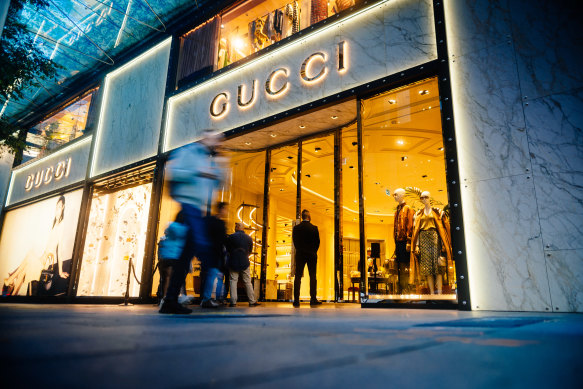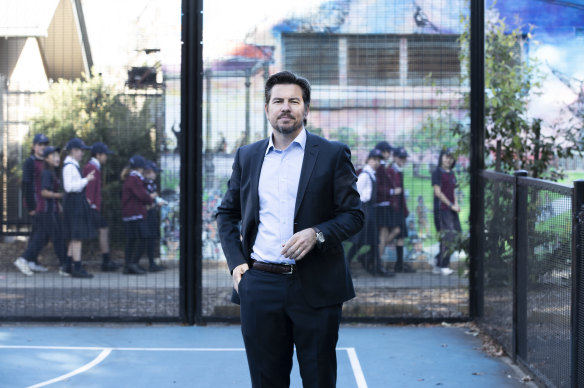Cost-of-living crisis? It pays to be a Boomer
By Colin Kruger
It’s been decades since Australia’s working poor were, well, this poor.
Beyond the cost-of-living crisis headlines, there is plenty of detail to show just how desperate it is getting for those bearing the full brunt of the economic crunch.
Calls to the National Debt Helpline traditionally have been triggered by one of two significant household events: unemployment or death. But in May this year, calls were up 51 per cent on 2022 levels thanks to the twin poxes of high mortgage rates and grinding inflation, which shows people are struggling despite a record number of Australians now holding down two jobs.

Despite the financial squeeze, luxury brands are hotter than ever. Credit: Dion Georgopoulos
Basic utility bills have now become an insurmountable financial burden for some. The Consumer Action Law Centre (CALC) reported that callers to its Victorian helpline last year identified energy bills as one of the top three areas of financial difficulty.
“What is clear is that low-income households are being priced out of an essential service,” CALC chief executive Stephanie Tonkin says.

Consumer Action Law Centre chief Stephanie Tonkin says low-income households can no longer afford basic services.
“People shouldn’t have to choose between putting food on the table and keeping their lights on or racking up debt they may never pay off.”
Even in boomtown Western Australia, Anglicare reports that 68 per cent of people are using its emergency relief services such as financial counselling, food assistance, emergency relief payments, are doing this for the first time.
And a rising number have a mortgage, which the charity has never experienced before.
It is a different level of desperation to the households that are downgrading to supermarket house brands and forgoing fresh fruit and vegetables, and the cascading effect on hospitality insolvencies. Credit reporting company CreditorWatch is forecasting that nearly one in 10 cafes, coffee shops and restaurants will go bust over the next year.
But anyone thinking the Reserve Bank’s blunt instrument of high interest rates is bludgeoning the entire country into financial penury might need to check on their nearest luxury car dealership.
In February, Lotus, Lexus and Lamborghini sales hit a record high. Porsche is also having a bumper year, according to the Federal Chamber of Automotive Industries.
The cruise business has also bounced back from pandemic lockdowns stronger than ever, with the rise in luxury cruising described as “incredible” by Travel Associates boss Rachel Kingswell. “We’ve never seen so much demand for expedition cruising from our clients,” she says.
Recent analysis of the consumer data by the Commonwealth Bank and Quantium joint venture, Commbank IQ, said spending on cruises leapt 22 per cent in the year to March 2024.
Airlines are also reporting soaring demand for the pointy end of the plane.

Demand for luxury cruises has never been stronger say industry insiders.
Flight Centre Travel Group’s corporate division says business class flight bookings nearly doubled for the 2024 financial year, up 94 per cent compared to 2023.
Analysts from Jarden Securities agree. In a recent report titled It pays to be a Boomer, they say Baby Boomers are driving growth in leisure spending as they retire, especially in the cruise market.
“[Baby Boomers] hold a disproportionate share of wealth and are now retiring and spending time travelling,” Jarden says.
This has also helped insulate Australian luxury retailers from the sector’s woes, with fashion houses such as Louis Vuitton and Gucci expanding their physical footprints in Australia.
And you don’t have to look far to find what is driving this enormous spend on luxury goods and services amid the headlines of incredible financial hardship: the truth is Australians have never been this rich.
Household net wealth hit a record $16.2 trillion in the March 2024 quarter, having risen for an incredible six quarters in a row. The most significant boost came from the rising value of property assets, which now exceed $11 trillion.
UBS chief economist George Tharenou says the level of dollar wealth is increasing at a remarkable rate of up to $1.5 trillion a year. “Household wealth per person is now around $600,000 on average, likely among the highest in the world,” he says.
Despite the RBA lifting debt repayments to a multi-decade high, Tharenou says consumer demand has remained resilient due to tax cuts, a robust labour market and rising property prices, which have offset interest rate worries.
“Basically, it appears the Australian household sector mindset has increasingly become ‘get rich or buy trying’; as long as they have a job.”
As a proportion of net household wealth, residential property now accounts for 68 per cent of household wealth, up from 61.7 per cent in December 2020. House prices are expected to rise even further due to building approvals in Australia not keeping up with demand in capital cities.
But it is not the only pot of gold for Aussie households, which also owned $1.46 trillion worth of shares – aided by the ASX, which recently topped 8000 for the first time.
Cash and deposit holdings of $1.73 trillion are also getting a big boost from the Reserve Bank’s high interest rates, which have boosted income from these cash deposits. That’s right, the interest-rate pressure designed to curb consumer demand is, perversely, easing the purse strings of those who are debt-free and cashed-up.
And then there is the $3.88 trillion in superannuation, supercharged by billions in tax concessions, now boosting the income of the fresh wave of Baby Boomer retirees cashing in to retirement.
UBS analyst Scott Russell says superannuation assets that are now in retirement phase – i.e. released to retirees – recently exceeded $1 trillion.
The investment group says retirement benefit payments hit a record $149 billion this year, which equates to 10 per cent of Australian household income, and this will only rise and create further complications for the Reserve Bank.
Wade Tubman, head of analytics at CommBank IQ, noted the seismic split between the cashed-up cohort of mortgage-free households – which makes up a third of the market – and the other two-thirds comprising renters and homeowners with a mortgage.
Owners with no mortgage increased their recreational spending by 14 per cent in 2023. Mortgage holders and renters increased it by 3 per cent, which means their spending went backwards in real terms.
CommBank IQ’s recent cost of living report showed that overall consumption by 25 to 29-year-olds shrank 7 per cent in real terms over the year to March. The over-60s categories were the only ones to show real growth in consumption.
Tubman says some of this represents the older generations coming out and starting their post-COVID revenge spend later than their younger cohorts, who are now being reined in by the cost of living crisis.
“Older people over the last six to 12 months really started to lean into things like travel, eating out all of those social experiences, while at the same time, younger people have faced these cost of living pressures, and have had to cut spending. So basically, the whole spending curve of the generations has flipped on its head.”
But whatever the cause, Australians who are enduring the worst of the current financial crisis must be asking themselves a worrying question: is the spending spree by this gilded group of Australians sabotaging the sacrifices made by the majority to tame inflation?

HSBC Australia chief economist Paul Bloxham says the luxury spending boom is not driving stubborn inflation numbers.Credit: Louie Douvis
For economists such as HSBC’s Paul Bloxham, the good news is that Boomers splashing out on luxury cars and other toys is not a problem. Goods inflation has staged an orderly descent back towards acceptable levels.
“The inflation problem we’ve got is that services inflation has stayed too elevated, and it’s proving to be sticky,” he says.
This stickiness is not a result of excessive demand either. It is the supply side that is proving problematic.
“We’ve slowed down demand, it’s just that the supply side of our economy, and productivity, has been so challenged that it hasn’t delivered the weakening of inflation,” Bloxham says.
“We need to have an even longer period of weak demand in order to get inflation back down to where it needs to be.”
CreditorWatch’s chief economist, Anneke Thompson, agrees with the thesis that goods inflation is under control but underlined just how difficult it will be to get services inflation – which is being driven by health, education and insurance costs – back in its box.

The rising cost of basic health services is one of the big contributors to stubborn inflation numbers. Credit: NSW Health
“Health inflation will be quite tricky to get under control because the population continues to age, and also, we’re struggling to find enough nurses and staff to meet the demand,” she says.
It is also immune to rising interest rates.
“We use health services regardless of where the cash rate sits in the monetary policy cycle,” Thompson adds.
It certainly will not impact the underlying forces driving up insurance costs, such as climate change and skyrocketing reinsurance costs.
Tubman points out that this is a significant counterbalance for these older, cashed-up Australians, who are shouldering the burden of the rise in the cost of essentials such as health, car and home insurance.
“What we’re finding is that a big chunk of the over-65 wallet is being diverted into these essential categories that are suffering from high inflation,” Tubman says.
These rising insurance costs are now the largest spending category by older generations, aside from grocery bills, and it is growing at a much faster rate.
Unlike food and clothing, they cannot trade down, which might explain the one category that has taken a hit across all generations: charity.
CommBank IQ’s report showed that charitable donations dropped 6 per cent year-on-year, with Tubman mentioning that they could not discern any other reason for the fall other than people cutting back on everything that they can.
“All age groups, irrespective of their pressures, in one way or another are cutting back,” he says.
Fundraising Institute Australia chief executive Katherine Raskob says a survey it conducted of charitable donors two months ago also showed that one in four had donated less over the past year with the vast majority citing the cost of living crisis.
“Any dip in charitable donations is concerning but especially during a cost of living crisis, as demand for the services charities provide has increased exponentially,” she says.
The Business Briefing newsletter delivers major stories, exclusive coverage and expert opinion. Sign up to get it every weekday morning.